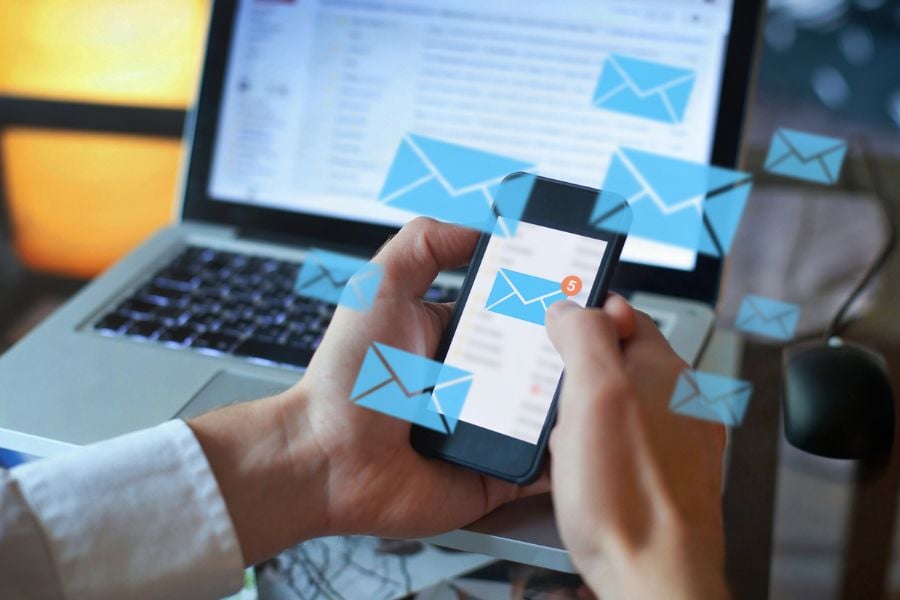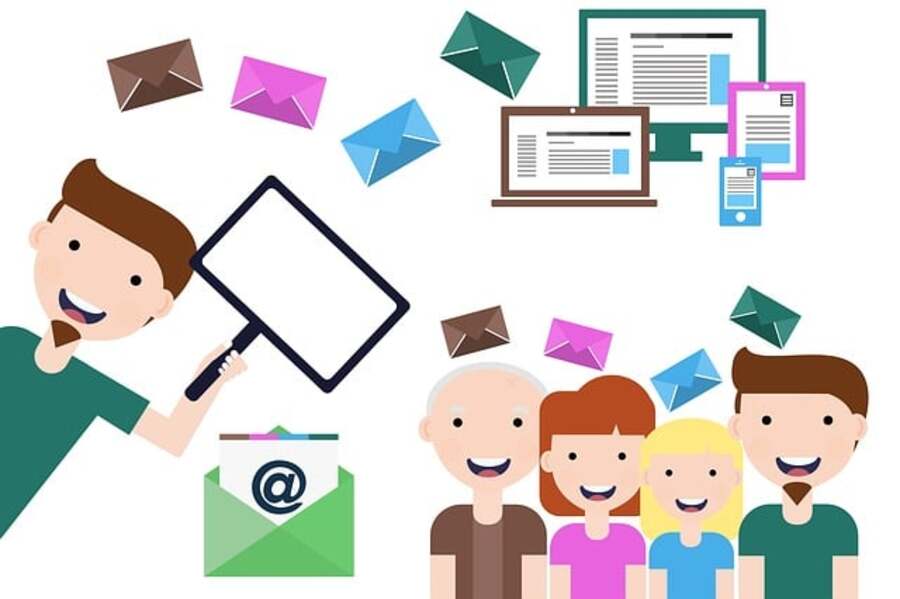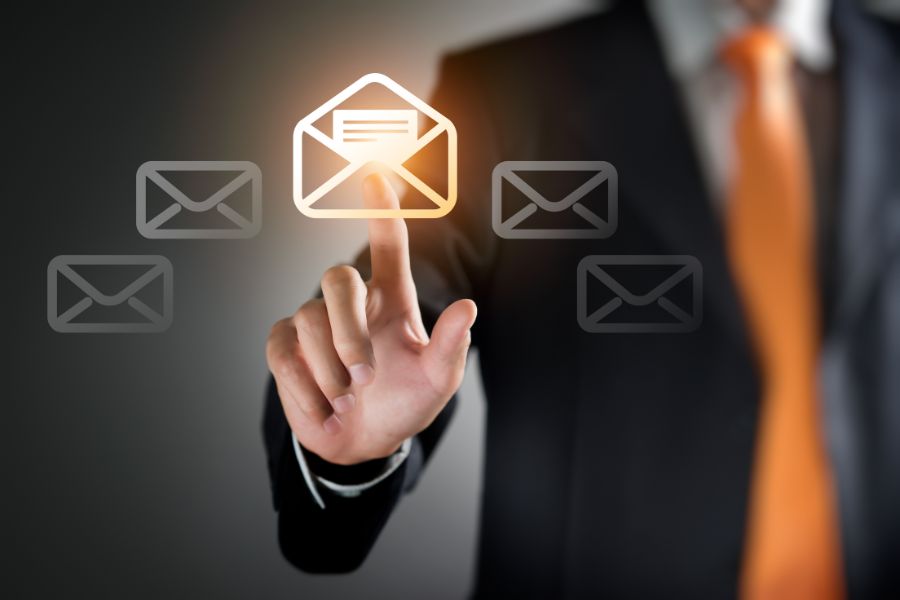Do you want to master the art of how to end an email? You’ve come to the right place.
You know the importance of first impressions.
You spend time crafting the perfect email. But the seemingly simple act of signing off makes your hands clammy.
You worry you sound too formal or familiar, vague, casual, or off-putting.
And you’re right to fret.
Because the closing presents a golden opportunity for connection and engagement, which most people fail to seize.
This blog post will give you 12 game-changing tips and ready-to-use templates to take your email endings from clumsy to classy.
Are you ready to make a lasting impression?
Let’s get cracking.

Why Your Email Sign Off Matters
Your email sign off matters more than you think when you email professionally.
It’s your final note, your last impression, and due to the psychological principle called the recency effect, your ending is often the most memorable part of your email message.
A well-crafted closing phrase can motivate the recipient to act, making your email, email signature, and contact information not only read but effective.
Conversely, a jarring or uninspired ending that seems like an afterthought may lead to indifference, causing your email to be ignored.
However, this doesn’t have to happen to you.
Let’s dive in and look at the tips that can transform your email closings.
12 Top Tips to Transform Your Email Sign Off


Effectively closing an email requires conciseness and an appropriate tone.
When you practice using these tips and the email template examples, you should see more engagement and response from your recipients. Even if you are sending a professional email to a close colleague or an informal email to a close friend.
1. Boost Your Response Rates With Prospects
The average worker receives 121 emails a day and sends around 40. This is email overload and it is understandable how many emails are not read.
You can increase response rates in several ways — an intriguing subject line, clear and to-the-point content, and an empathetic call-to-action are some decisive factors.
But above all, your professional email endings should sound authentic.
Let’s look at examples that can boost your response rates…
Conventional:
- “Best regards,”
- “Kind regards,”
- “Warm regards,”
Unconventional:
- “Looking forward to hearing your thoughts,”
- “Please let me know what you think,”
- “Eager to chat more about this soon,”
2. Craft Irresistible Sign Offs
Elevate your sign offs by being creative and using humor wisely.
In a business email, it’s best to avoid going over the top, as it can cause more cringe than enthusiasm.
Remember, the best business email sign off is the one that fits the tone of the email and the relationship you have with the recipient.
Let’s check out these examples…
Conventional:
- “Onward and upward,”
- “To your success,”
- “Virtually yours,”
Unconventional:
- “Ready for our next adventure,”
- “In the spirit of progress,”
- “To infinity and beyond,”
3. Use Active and Engaging Language in Your Professional Sign Off
Infusing your correspondence with active language can captivate your reader and effectively convey your messages.
So, engage your recipient into action by incorporating action verbs and personal pronouns like “you.”
Let every word of your ending count, creating action and connection.
For example…
Conventional:
- “Thank you for your time,”
- “I’m eager to hear your thoughts,”
- “I appreciate your guidance,”
Unconventional:
- “You are a profound inspiration,”
- “I’m eagerly awaiting our next brainstorm,”
- “Let’s break boundaries and make a dent in the universe,”
4. Show Appreciation and Gratitude in Your Professional Email Closing

Expressing appreciation and gratitude is one of the best ways to connect with your network.
Remember, authenticity is critical when expressing appreciation and gratitude, so tailor the email closing line to the situation and the recipient.
Let’s look at a few examples…
Conventional:
- “With deep gratitude,”
- “Thank you for your time,”
- “I appreciate your help,”
Unconventional:
- “I’m so grateful for our collaboration,”
- “I deeply appreciate your support and guidance,”
- “I’m so impressed and energized by your work and commitment,”
5. Deliver a Clear and Focused Message to Your Email Recipient
Crystal clear writing is a gift your recipient will appreciate.
In email endings, clarity and focus could mean providing the next steps you or the recipient must take, or it could include your contact information.
Let’s check out these examples…
Conventional:
- “Get back to me as soon as you can,”
- “Let me know when we can meet,”
- “Please email your cover letter as soon as possible,”
Unconventional:
- “Let’s get this done and move forward,”
- “You can reach me at [insert number] tomorrow around noon,”
- “Call me at [insert number] when you have more to discuss,”
6. Unlock the Power of Call-to-Actions (CTAs) in Your Professional Closing
Make sure your professional email has a clear call-to-action (CTA). A powerful CTA produces a sense of urgency in the reader to act.
Your CTA should be specific, leaving no room for doubt.
So, craft the CTA with your professional email recipient’s point of view in mind.
Some effective examples include…
Conventional:
- “Let’s schedule a call to discuss this further in detail,”
- “Please confirm if you are available for a call,“
- “Let me know what you think,”
Unconventional:
- “Take the next step and schedule a call with me,”
- “Do you have any thoughts? Let’s schedule a chat,”
- “Please jump in and let me know your thoughts,”
7. Capture Attention with P.S. in Your Email Closing Sentence
There is something alluring about a postscript (P.S.) after the email signature.
So much so that many people read the P.S. first when they skim an email.
The postscript can be an additional piece of information that creates urgency in the recipient.
For example…
Conventional:
- “P.S. Don’t forget to check our website for more information.”
- “P.S. Please let me know if you have any further questions.”
- “P.S. Let me know if you need help with [project/task].”
Unconventional:
- “P.S. Check out this free guide that we are making available just for you [link to guide].”
- “P.S. This exclusive offer expires at midnight. Don’t miss out!”
- “P.S. We only have a few seats left for our upcoming webinar. Reserve yours today!”
8. Address Potential Objections or Concerns in Your Professional Closing
The closing line of your email also allows you to address any objections or concerns in your professional email communication.
In addition to dealing with objections directly, you can also provide solutions with a call to action in your email ending.
Anticipating objections shows empathy, builds trust, and can improve response rates.
Check out these examples…
Conventional:
- “Please let me know if you have any reservations,”
- “You have our complete support,”
- “If you have any problems, we’re here to assist,”
Unconventional:
- “I’m here for all your questions. We got this!”
- “Do you have any concerns? I’m all ears and ready to help,”
- “If you’re feeling a little hesitant, I’m here to chat,”
9. Ask Open-Ended Questions to Encourage Engagement in Business

Asking open-ended questions in the closing line of a business email correspondence encourages the recipient to engage.
Questions such as “what” and “how” creates meaningful responses and further conversation to develop.
Be genuinely curious and encourage active participation in your business email closing line.
For instance…
Conventional:
- “How do you think [product/service] could benefit your business?”
- “How can we assist in making your decision easier?”
- “What are your thoughts on our proposal?”
Unconventional:
- “How can we make your dreams come true?”
- “What does the ideal outcome of our partnership look like to you?”
- “How can we support you?”
10. Highlight the Unique Selling Proposition (USP) in Your Sales Email Closing
An email closing is the perfect place to underline your unique selling proposition (USP) in a sales email, especially when sending a cold email.
When you emphasize the benefits and provide evidence of your USP, you engage the prospect by appealing directly to their needs.
Consider these examples…
Conventional:
- “Our team’s dedication to [insert USP] sets us apart from our competitors.”
- “Our [insert USP] ensures you get the best possible outcome.”
- “Our software is built on [insert USP], ensuring optimal performance.”
Unconventional:
- “Imagine what you could achieve with [insert USP].”
- “We don’t just offer [insert USP]; we promise transformation.”
- “Think of our [insert USP] as your secret weapon.”
11. Evoke Emotion and Inspire Action in Formal Correspondence
Carefully curated stories can build connection, while emotional triggers can stimulate people to act.
Research by Harvard Professor Gerald Zaltman has shown that subconscious emotions prompt 95% of purchasing decisions.
Inciting positive emotions in formal email correspondence is a great way to build rapport and inspire action.
These formal closing examples show you how…
Conventional:
- “Your ideas always energize me, ”
- “I appreciate the extraordinary work you do,”
- “I’m honored to work with you,”
Unconventional:
- “I have a feeling that [product/service] will transform your business,”
- “The insights you brought last time energized our team,”
- “Your drive and tenacity inspire me,”
12. Use a Strong, Action-Oriented Closing Line Above Your Email Signature

The last lines of your email present a final opportunity to inspire action, so you should shape them carefully.
By providing value in your email ending, you remind your recipient of what’s in it for them. Show the recipient that you’re in it together.
Check out these examples…
Conventional:
- “Don’t miss out!”
- “Let’s explore more of our ideas together,”
- “Ready to face any challenges ahead!”
Unconventional:
- “Let’s go forth and conquer!”
- “Ready to take the plunge and disrupt!”
- “Here’s to breaking boundaries and creating a legacy together,”
Now that you learned how to engage your email recipients with your email sign offs, it’s your turn to show what you can do with your own professional and personal email closings.
How to End an Email: Practice Makes Perfect
Ending an email well is an art but not one that requires genius.
Through practice and determination, you can craft graceful formal email closings that resonate with each email recipient.
Here’s your next step…
Pick one email today, just one. Give it the royal treatment. Craft your sign-off using the tips and tweaking the email templates we’ve explored.
Mix things up, be authentic, stay appropriate to the relationship and the context, and remember: We’re all in this email business together.
Now go forth and close each email with complete confidence.
The post How to End an Email: 10+ Game-Changing Tips (& Templates) appeared first on Smart Blogger.

No comments:
Post a Comment